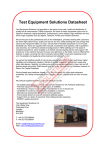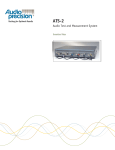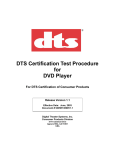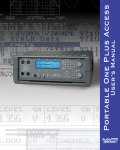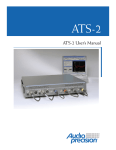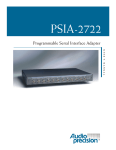Download DCX-127 Multifunction Module User's Guide
Transcript
DCX-127 Multifunction Module User’s Guide June 2000 Audio Precision PN 8211.0122 Version 0 Copyright © 2000 Audio Precision, Inc. All rights reserved. No part of this manual may be reproduced or transmitted in any form or by any means, electronic or mechanical, including photocopying, recording, or by any information storage and retrieval system, without permission in writing from the publisher Audio Precision®, System One®, System Two™, System Two Cascade™, System One + DSP™, System Two + DSP™, Dual Domain®, FASTTEST®, and APWIN™ are trademarks of Audio Precision, Inc. Windows is a trademark of Microsoft Corporation. Published by: ® Audio Precision, Inc. PO Box 2209 Beaverton, Oregon 97075-2209 U.S. Toll Free: 1-800-231-7350 Tel: (503) 627-0832 Fax: (503) 641-8906 Email: [email protected] Web: www.audioprecision.com Printed in the United States of America CONTENTS Safety Information . . . . . . . . . . . . . . . . . . . v Safety Symbols . . . . . . . . . . . . . . . . . . . . . vi Disclaimer. . . . . . . . . . . . . . . . . . . . . . . . vi Description. . . . . . . . . . . . . . . . . . . . . . . . 1 Scope of This Manual . . . . . . . . . . . . . . . . . . 1 Introduction . . . . . . . . . . . . . . . . . . . . . . 1 DC Voltage Measurements . . . . . . . . . . . . . . . 2 Resistance Measurements . . . . . . . . . . . . . . . 3 DC Voltage Outputs. . . . . . . . . . . . . . . . . . . 5 Digital Input . . . . . . . . . . . . . . . . . . . . . . 6 Digital Output . . . . . . . . . . . . . . . . . . . . . . 7 Program Control Outputs . . . . . . . . . . . . . . 8 Auxiliary Output Ports . . . . . . . . . . . . . . . . 10 Installation . . . . . . . . . . . . . . . . . . . . Mounting . . . . . . . . . . . . . . . . . . . . Primary Power Considerations . . . . . . . . Checking or Changing Power Line Voltage . Fuse Information . . . . . . . . . . . . . . . . Changing Fusing Arrangement . . . . . . . . Power Switch . . . . . . . . . . . . . . . . . . Proper Environment . . . . . . . . . . . . . . Connecting the APIB Interface. . . . . . . . . . . . . . . . . . . . . . . . . . . . . . . . . . . . 11 11 11 11 13 14 15 15 16 Operation . . . . . . . . . . . . . Panel . . . . . . . . . . . . . . . Volts/Ohms Measurements . . DC Output 1 and 2 On/Off. . . DC Output 1 and 2 Value . . . Digital Input and Output . . . Program Control, Gate Delay. Auxiliary Outputs . . . . . . . . . . . . . . . . . . . . . . . . . . . . . . . 17 17 18 21 21 22 25 26 . . . . . . . . . . . . . . . . . . . . . . . . . . . . . . . . . . . . . . . . . . . . . . . . . . . . . . . . . . . . . . . . Specifications . . . . . . . . . . . . . . . . . . . . . 29 DCX-127 Multifunction Module User’s Guide Page iii Safety Information Do NOT service or repair this product unless properly qualified. Only a qualified technician or an authorized Audio Precision distributor should perform servicing. Do NOT defeat the safety ground connection. This product is designed to operate only from a 50/60 Hz AC power source (250 Vrms maximum) with an approved three-conductor power cord and safety grounding. Loss of the protective grounding connection can result in electrical shock hazard from the accessible conductive surfaces of this product. For continued fire hazard protection, fuses should be replaced ONLY with the exact value and type as indicated on the rear panel and in Section of this document. The AC voltage selector also must be set to the same voltage as the nominal power source voltage (100, 120, 230, or 240V rms) with the appropriate fuses installed. The International Electrotechnical Commission (IEC 1010-1) requires that measuring circuit terminals used for voltage or current measurement be marked to indicate their Installation Category. The Installation Category is defined by IEC 664 and is based on the amplitude of transient or impulse voltage that can be expected from the AC power distribution network. This product is classified as INSTALLATION CATEGORY II, abbreviated “CAT II” on instrument front panels. Do NOT substitute parts or make any modifications without the written approval of Audio Precision. Doing so may create safety hazards. This product is for indoor use - pollution degree 2. Use this equipment only for switching applications as described in this manual. Page iv DCX-127 Multifunction Module User’s Guide Safety Symbols Safety Information Safety Symbols The following symbols may be marked on the panels or covers of equipment or modules: WARNING! - This symbol alerts you to a potentially hazardous condition, such as the presence of dangerous voltage that could pose a risk of electrical shock. Refer to the accompanying Warning Label or Tag, and exercise extreme caution. ATTENTION! – This symbol alerts you to important operating considerations or a potential operating condition that could damage equipment. Refer to the User’s Manual or Operator’s Manual for precautionary instructions. FUNCTIONAL EARTH TERMINAL – This symbol marks a terminal that is electrically connected to a reference point of a measuring circuit or output and is intended to be earthed for any functional purpose other than safety. PROTECTIVE EARTH TERMINAL – This symbol marks a terminal that is bonded to conductive parts of the instrument. Confirm that this terminal is connected to an external protective earthing system. Disclaimer Audio Precision cautions against using their products in a manner not specified by the manufacturer. To do otherwise may void any warranties, damage equipment, or pose a safety risk to personnel. DCX-127 Multifunction Module User’s Guide Page v Description Scope of This Manual This manual serves several purposes: § It will help you install the DCX-127 Multifunction Module. In addition to the instrument capabilities, descriptions of all connectors are given. § It presents specifications of the DCX-127. § It contains some fundamental APWIN assistance relating to the use of the DCX-127. Introduction The DCX-127 Multifunction Module contains an autoranging 4-1/2 digit dc voltmeter-ohmmeter, two 20-bit programmable dc voltage sources, 21 bits of digital I/O, and three 8-bit programmable auxiliary output ports for device control or status indicators. Typical applications include A/D and D/A converter testing, VCA gain control linearity, VCA distortion, amplifier dc offset and power supply checks, power amplifier load switching control, loudspeaker voice coil resistance measurements, temperature measurements, and test fixture control. The DCX-127 also provides pulses and dc levels whose timing depend upon key software actions such as end of sweep, analyzer channel selection, or data settling. These may be used for synchronization and sequencing of external devices or portions of the test system such as the triggered sine burst generator. The DCX-127 functions include: § DC voltage and resistance measurement from 200 mV to 500 V and 200 W to 2 MW full scale, fully floating and guarded for accurate measurements in the presence of large common mode voltages. Readings can be offset and scaled by the software. DCX-127 Multifunction Module User’s Guide Page 1 DC Voltage Measurements Description § Resistance measurements using either 4-wire or 2-wire techniques. § Two independently programmable bipolar floating DC voltage outputs, each with a ±10.5 V range, 20 mV resolution and monotonicity to 40 mV (19 bits). The software can sweep either dc source. § Digital input of static or low-speed parallel input, word width up to 21 bits. § Digital output of a parallel digital word of 21 bits. § A simplified 8-bit program control interface that can be defined to execute any pre-defined keystroke sequence. This can be used to run different software procedures based upon switch closures. All the DCX-127 output functions are controlled from APWIN software, and all of the inputs are displayed in APWIN software and may be displayed as bargraphs or plotted values during a sweep when appropriate. The DCX-127 Multifunction Module is a separate unit packaged in a one-rack-unit high case that may be rack-mounted or used as a bench instrument. The following sections describe the capabilities in greater detail. Complete specifications can be found at the end of this manual. DC Voltage Measurements The DCX-127 includes a 4-1/2 digit autoranging dc voltmeterohmmeter. In voltage mode, the meter will automatically select among its 200 mV, 2 V, 20 V, 200 V, or 500 V ranges for best resolution of the measured signal. It may also be fixed on any of its ranges. The meter has selectable reading rates of 6 or 25 readings per second. The 6/second selection provides full 4-1/2 digital resolution (20,000 counts full scale). The 25/second selection also displays 4-1/2 digits, but the last digit will always be either 0 or 5. Normal mode rejection and common mode rejection also degrade by approximately a factor of Page 2 DCX-127 Multifunction Module User’s Guide Description Resistance Measurements four when the 25/second reading rate is selected. Resolution versus range and reading rate are shown in Table 1. Table 1. Reading rate for various ranges Range Resolution 6/s Rate Resolution 25/s Rate 200 mV 10 uV 50 uV 2V 100 uV 500 uV 20 V 1 mV 5 mV 200 V 10 mV 50muV 500 V 100 mV 500 mV Resistance Measurements The resistance mode operates by forcing a calibrated value of current through the unknown resistance and measuring the consequent voltage drop. The ohmmeter is autoranging and will select either the 200 W, 2 kW, 20 kW, 200 kW, or 2 MW range depending on the value of the unknown resistance being measured. It may also be fixed on any range. Reading rates of 6 readings per second or 25 readings per second may be selected. Software features also permit displaying a computed value which is a function of resistance, using user-entered values of offset and scale parameters. The DCX-127 input configuration permits making these resistance measurements on either a 2-wire or 4-wire basis. DCX-127 Multifunction Module User’s Guide Page 3 Resistance Measurements Description Two-wire connection Figure 1. Simplified diagram of Iref 2-wire ohmmeter operation Rw (test lead) -SOURCE Icomp +INPUT 600 Rx (unknown) Vmeas Rw (test lead) 600 -INPUT If only one pair of test leads is used, connected from the (+) and (-) terminals of the DCX-127 to the unknown resistance, a 2-wire measurement results. Current from the internal current source flows through an internal resistor, through the test leads and resistance being measured, and through another internal resistor back to the current source. The two internal resistors are indicated schematically on the front panel of the DCX-127. Voltage drop across these internal resistors, produced by this current, is internally measured at the (+) and (-) terminals. The resistance of the two test leads is thus included in the measurement. For moderate and high values of unknown resistance, the additional error introduced by resistance of the test leads is usually negligible. Page 4 DCX-127 Multifunction Module User’s Guide Description DC Voltage Outputs Four-wire (Kelvin) connection Figure 2. Simplified diagram of 4-wire ohmmeter operation +INPUT 600 Iref Rw -SOURCE Icomp Rw (test lead) Rx (unknown) Vmeas Rw (test lead) Rw 600 -INPUT For the highest accuracy when measuring low values of resistance, we recommend a 4-wire measurement (Kelvin lead connection). For this measurement, connect one pair of test leads from the two current source connectors (marked SOURCE) to the unknown resistance. Connected a second pair of test leads from the voltmeter input terminals (+ and - jacks) to the unknown. Now current from the current source does not flow through the voltmeter leads, so the resistance of the test leads is not included in the measurement. The resolution of the reading varies with the range and with the reading rate as shown in Table 1 on page 3. DC Voltage Outputs Two independent dc voltage outputs are available at the DCX-127 front panel. Each output may be set with 20 microvolt resolution (approximately 20 bits equivalent) to any voltage in the ±10.5000 volt range. DCX-127 Multifunction Module User’s Guide Page 5 Digital Input Description Figure 3. Equivalent circuit, DC Outputs 1 or 2 + Vout - T Example applications of the dc outputs include sweep control of the gain, offset, or both ports of voltage-controlled amplifiers (VCAs) while measuring their gain, distortion, or noise and plotting those values versus control voltage. The dc output can also be used to control the position of a dc-controlled turntable while measuring polar response patterns of a loudspeaker or microphone. Manually operated test equipment with a dc control port (such as the VCF input of a function generator) may be controlled by the dc outputs. Tape machines with dc-controllable bias oscillators may be connected, enabling MOL, SOL, sensitivity, and other data to be taken automatically. The dc outputs may be floated up to 2 volts away from ground. See Figure 3 for the equivalent output circuit of both dc outputs. Maximum current sourced from each is 20 milliamperes. The maximum current that the DC outputs can sink is 10 milliamperes. Digital Input A common application of the digital input is in static (DC) linearity testing of A/D converters. The digital input may also be used to interface readings from a BCD-display instrument such as a capacitance meter to the audio test system. Page 6 DCX-127 Multifunction Module User’s Guide Description Digital Output A parallel digital word of up to 21 bits plus sign bit, at LSTTL-compatible levels, may be connected to the digital input connector on the front panel of the DCX-127. The value of this word may be displayed in decimal or hexadecimal representations. A user-entered scale factor may be entered and a function of actual input displayed, multiplied by the scale factor. The digital word presented to the connector may be in either two’s complement (binary plus a sign bit) or 8-4-2-1 binary coded decimal (BCD) format. The word at the connector may either be asynchronously sampled at any of four different selectable reading rates or, in external mode, displayed each time a “data good” or “conversion completed” pulse is presented at pin 25. The maximum sampling rate depends largely on computer speed. Digital Output An LSTTL-compatible parallel digital output word of up to 21 bits plus a sign bit may be created at the digital output connector. The value of the word may be entered into the software in either decimal or hexadecimal representations or scaled decimal. The format of the word (bit-to-pin relationship) may be selected as two’s complement or 8-4-2-1 binary coded decimal (BCD). The strobe line (pin 25) will be pulsed low each time a new value is entered into the software panel or stepped to during a sweep. A typical application of digital output is in static (dc) linearity testing of digital-to-analog converters. The digital output word drives the converter; the analog output of the converter is measured with the DCX-127 DVM. For high-resolution converters at output voltages more than ±200 mV away from zero, it will be desirable to use one of the DCX-127 dc outputs in conjunction with the DVM input in differential voltmeter fashion so that the DVM can be set on its highest resolution range. Another application of the digital output is control of digitally-controllable turntables during polar response testing of microphones and loudspeakers. Still another application is in testing multiplying digital-to-analog converters (MDACs) used as variable resistors, attenuators, or in other audio applications. Each bit output has a five-milliampere current drive capability and 390 ohms output impedance. DCX-127 Multifunction Module User’s Guide Page 7 Digital Output Description Program Control Outputs The Program Control Output connector provides six pulse or gate signals controlled by various actions of APWIN software. The pin assignments are shown in the Table above. All lines are LSTTL compatible. The Reset output, pin 2, pulses high when the DCX-127 power is turned on and whenever a Util Restore menu command is executed. The Reset output would typically be used to normalize the condition of external logic devices connected to a System One or System Two test station at power up. It may also be invoked in a procedure by inserting a Util Restore command into the procedure. The Data Acquired output, pin 3, pulses high each time that a set of data satisfies the settling algorithm. See the Sweep Settling section for full details on the settling algorithm. This signal could be used, for example, to cause a compact disc player to automatically advance to the next track whenever a successful set of measurements is completed on the preceding track. This is useful during an external frequency or external amplitude test across a series of tracks of a test disc. The Trigger output, pin 4, pulses high at the end of each delay portion of the settling process. In a generator-based sweep, settling delay is the time after the generator steps to a new value but before the software starts examining data samples to see if they are settled. This signal could be viewed on a dual-trace oscilloscope along with the signal being measured, to verify that the delay has been optimally set to discard “left over” data from the previous generator step. This is useful when measuring systems such as 3-head tape recorders or satellite paths, which have significant time delays. The Trigger output of the DCX-127 could also be connected to the trigger/gate input of the generator when the BUR-GEN module is present. This will synchronize tone bursts in the sine trig mode with the system’s readiness to make a measurement. The Trigger output could also be used to strobe an external device being tested, such as an analog-to-digital converter. This will help insure that the source is stable before the conversion takes place. The Sweep Gate output, pin 6, drops low at the beginning of a sweep test and goes high at the completion of a test. In a nested sweep, Page 8 DCX-127 Multifunction Module User’s Guide Description Digital Output it will go high momentarily at the end of each Source-1 sweep and drop low again for the next Source-1 sweep after the Source-2 parameter is incremented. One example application of the Sweep Gate output is in testing of the attack characteristics of compressors, limiters, and similar audio processors. With the Sweep Gate connected to the trigger/gate input of the generator when the BUR-GEN module is present and the Burst-gated mode is selected, time zero on a time sweep graph and the start of the signal will be synchronized. The Channel A/B output, pin 7, goes low whenever analog analyzer input channel A is selected and high whenever input channel B is selected. The level at this pin thus indicates which channel is being measured during a stereo sweep. The Delay Gate output, pin 1, is similar to the Sweep Gate signal but with the addition of a user-settable delay time between the actual beginning of a sweep test and the leading edge of the gate output signal. This delay time is entered at the bottom of the DCX software panel, in the Gate Delay field. An example application is power amplifier turn-on and turn-off transient (“thump”) testing. The amplifier power could be turned on by the sweep gate and off by the delayed gate. The output of the amplifier may be measured during a time sweep. To allow correct capture of transients, the Level meter should be used along with a fixed input range. Another example application is to start a tape machine or turntable for run-up time testing. The basic measurement technique is to perform a time sweep while measuring frequency from a pre-recorded tape or disc. Use of the Delayed Sweep Gate to start the recorder or turntable permits the instrument to draw the graph when ( is pressed, start the time sweep, and then start the machine at a predetermined time into the sweep when the software is ready to take continuous, rapid measurements. DCX-127 Multifunction Module User’s Guide Page 9 Auxiliary Output Ports Description Auxiliary Output Ports Three rear-panel 9-pin connectors are provided on the DCX-127 for digital control of external devices. These output ports are intended for direct interface to LSTTL circuitry, or via LSTTL-compatible drivers to relays. Control of power, lights, and annunciators are among the possible applications. The pin connections of these ports are shown below. The current drive capability of each bit line is five milliamperes; the output impedance is 390 W. A fourth auxiliary output, J141, is similar to Ports A, B, and C, but has a 15-pin connector that also includes +5 V, +15 V, and -15 V power supplies. Page 10 DCX-127 Multifunction Module User’s Guide Installation Mounting DCX-127 modules may be either rack-mounted or simply stacked with other instruments. They do not consume appreciable power, and therefore require no extraordinary ventilation considerations. The modules occupy one rack unit of height (1.75 inches). They are provided with bottom feet for tabletop use. The optional rack mount adapters available from Audio Precision (order number RAK-212) allow either conventional flush front mounting or setback mounting to prevent the front connectors from protruding from the rack. Primary Power Considerations Checking or Changing Power Line Voltage Housing Indicator Pin Voltage Selector Card Fuse Block Cover Figure 4. Changing power line voltage The AC Mains input to each instrument is made through a connector/fuse block/voltage selector assembly. Before connecting the power cord, confirm that the input voltage selection is correct for your DCX-127 Multifunction Module User’s Guide Page 11 Primary Power Considerations Installation power source. An indicator pin shows the selected input voltage in one of the four holes in the cover (see Figure 4). To change the input voltage, refer to and proceed as follows: 1. Remove the AC power cord from the AC Mains Connector. 2. Open the cover, using a small blade screwdriver or similar tool. Set aside the cover/fuse block assembly. 3. Pull the voltage selector card straight out of the housing, using the indicator pin. 4. Orient the selector card so that the desired input voltage is readable at the bottom (see Figure 5). Then orient the indicator pin to point up when the desired voltage is readable at the bottom, with the indicator pin assembly seated in the notch on the board edge. 100 V 90º 120 V 90º 230 V 90º 240 V Figure 5. Voltage selector card positions 5. Insert the voltage selector card into the housing with the printed side of the card facing toward the connector, and the edge indicating the desired voltage first. 6. Confirm that the correct fuse is installed for the intended input voltage (refer to fuse ratings marked on the rear panel or in the manual). If necessary, change the fuse type as described in the following section. 7. Replace the cover and verify that the indicator pin shows the desired voltage. Page 12 DCX-127 Multifunction Module User’s Guide Installation Fuse Information Fuse Information The connector/fuse block/voltage selector assembly allows two fusing arrangements: North American (see Figure 6) and European (see Figure ). The North American fusing arrangement uses a single type 3AG (0.25 x 1.25 in.) SB (“slow blow”) fuse; the European fusing arrangement uses two 5 x 20 mm IEC-approved type T fuses. Both types should be rated 250 V. Fuse current ratings are 200 mA for 100 – 120 V inputs, or 100 mA for 230 – 240 V inputs. Confirm this information on the label on rear panel. Jumper bar Fuse block Fuse Cover Figure 6. North American fusing arrangement Fuses Fuse block Cover Jumper bar Figure 7 . European fusing arrangement DCX-127 Multifunction Module User’s Guide Page 13 Changing Fusing Arrangement Installation Changing Fusing Arrangement To change from one fusing arrangement to the other: j 1. Remove the AC power cord from the AC Mains Connector. 2. Open the cover of the connector/fuse block/voltage selector assembly with a small blade screwdriver or similar tool. 3. On the back of the cover, loosen the Philips screw two turns, then remove the fuse block by sliding up, then away from the screw and lifting from pedestal at the other end (refer to Figure 8). Fuse Fuse block Cover Figure 8. Changing fuse types 4. Invert the fuse holder and reassemble it on the Philips screw and pedestal, and tighten the screw. 5. Change or add the correct fuses as necessary (again, refer to rear panel for the correct fuse current rating). 6. Confirm the line voltage setting as described in the previous section, then replace the cover. Page 14 DCX-127 Multifunction Module User’s Guide Installation Connecting the APIB Interface Power Switch Figure 9. DCX-127 Power switch The DCX-127 POWER switch is a push-on, push-off button located on the right end of the front panel (see Figure 9). An LED indicator next to the switch shows when power is applied. Proper Environment All Audio Precision products are intended for use indoors, in a normal environment. Refer to the specifications for temperature range and humidity specifications. Connecting the APIB Interface The DCX-127 has two APIB connectors on its rear panel. They permit connecting instruments in a “daisy-chain” fashion between the computer’s APIB card connector and the System One, System Two, or System Two Cascade APIB connector. The connectors pass the APIB lines through, and instruments respond only when specifically addressed, as described below. Normally, the computer will be connected to the first instrument with a digital interface cable, the first instrument connects to the second, etc, and the last instrument DCX-127 Multifunction Module User’s Guide Page 15 Connecting the APIB Interface Installation connects to the system digital interface (APIB) connector. A typical installation is shown in Figure 10. SYSTEM TWO CONFIGURATION System Two SYS 2022 Analog Only System Two SYS 2222 Analog+DSP System Two SYS 2322 Dual Domain System Two SYS 2300 Digital Only O P T I O N S IMD W&F BUR EURZ SPCL Date of Manufacture F I L T E R S 1 R 2 3 System Two 4 5 6 Manufactured in Beaverton, Oregon, USA 7 This product is protected by one or more of the following patents: 4,614,914; 4,563,652; 4,631,522; 5,089,981; 5,136,267; 5,265,201; 5,247,458; 5,420,516; 5,336,989. Other patent applications pending. SUPPLY VOLTAGE: 100/120/230/240 VAC FREQUENCY: 50/60 Hz MAXIMUM POWER: 240 VA FUSE REPLACEMENT DATA SUPPLY VOLTAGE FUSE 100/120 VAC 2A T/SB 250V 230/240 VAC 1A T/SB 250V AUXILIARY OUTPUTS SUPPLY VOLTAGE: 100/120/230/240 VAC FREQUENCY: 50/60 Hz. MAXIMUM POWER: 20 VA J141 FUSE REPLACEMENT DATA SUPPLY VOLTAGE PORT C PORT B PORT A FUSE 100/120 VAC 200 mA T/SB 250V 230/240 VAC 100 mA T/SB 250V Manufactured in Beaverton, Oregon, USA APIB INTERFACE APIB INTERFACE SUPPLY VOLTAGE: 100/120/230/240 VAC FREQUENCY: 50/60 Hz. MAXIMUM POWER: 20 VA FUSE REPLACEMENT DATA SUPPLY VOLTAGE FUSE 100/120 VAC 200mA T/SB 250V 230/240 VAC 100mA T/SB 250V SUPPLY VOLTAGE: 100/120/230/240 VAC FREQUENCY: 50/60 Hz. MAXIMUM POWER: 20 VA FUSE REPLACEMENT DATA SUPPLY VOLTAGE FUSE 100/120 VAC 200mA T/SB 250V 230/240 VAC 100mA T/SB 250V Figure 10. APIB connections block diagram (typical; shown with DCX-127 and two switchers) Page 16 DCX-127 Multifunction Module User’s Guide Operation Panel When APWIN is running, there are two ways to bring the DCX panel to the screen: § Mouse: Click on the DCX-127 icon Panels DCX via the menu bar § Keyboard: Type Apx on the toolbar or select (for Panels DCX-127). Figure 11. DCX-127 panel, small version The DCX-127 Panel can be viewed in both large and small versions. Clicking on the panel icon on the Panels Toolbar brings up the small version panel, shown in Figure 11. Holding down the S key while clicking on the toolbar icon brings up the large version, shown in Figure 12. You can also click the Maximize button to toggle the two sizes. In addition to bringing the panels on screen manually as described here, all parameters can be set by APWIN BASIC commands. Refer to your APWIN BASIC Extensions Reference Manual for full details. DCX-127 Multifunction Module User’s Guide Page 17 Panel Operation Figure 12. DCX-127 panel, large version Volts/Ohms Measurements Figure 13. Connectors for volt/ohms measurements Page 18 DCX-127 Multifunction Module User’s Guide Operation Panel DMM Units In DC Volts function, the reading may be displayed either in absolute volts or as f(V), a function of volts, after modification by Offset and Scale factors. Similarly, resistance readings may be displayed in ohms or as f(O) with Offset and Scale. The “available units” list includes only units valid for the presently-selected function (DC V or ohms). Auto/Fixed Range Checkbox The voltmeter/ohmmeter may operate in autoranging mode or may be fixed on any one of its full-scale ranges. When the DMM Autoranging function is disabled (no check mark in Auto box), a Range field is displayed and active for manual range selection. New entries may be typed in or existing entries edited from the keyboard, and completed by pressing the E key. When E is pressed, APWIN software will select and display the most-sensitive range that can handle the entered value. Offset and Scale Values for f(V), f(O) When f(V) (function of volts) or f(O) (function of ohms) units are selected for the DMM, APWIN software computes the value to display from the formula display = (measurement + Offset) * Scale. The “measurement” term is the value which would be displayed in volts or ohms units. The “Offset” and “Scale” values are the contents of the fields with those names, at the top right of the DCX-127 panel. New entries may be typed into either field, or the existing entry edited, from the keyboard followed by pressing the E key. DCV/Ohms/Off Selection The DMM (digital multimeter) can measure dc volts or ohms, or be turned off, by use of the three buttons below the Auto Range check box. DCX-127 Multifunction Module User’s Guide Page 19 Panel Operation Reading Rate The DMM can operate at 6 or 25 readings per second. Resolution is a full 4-1/2 digits at 6 readings per second. At 25 readings per second, the number of digits displayed is the same but the least significant digit is always 5 or 0. Guard The Guard terminal is connected to a shield enclosing the DMM board. Connecting the Guard terminal may improve some voltage and resistance measurement accuracy and reduce noise under certain conditions: § When operating the DMM in the presence of high-level radiated noise (most commonly, stray fields at line frequency); § When long test leads are used to measure a high signal source impedance; § When floating measurements are made in the presence of a high common-mode voltage, or frequency, or both. To use the Guard, connect its terminal to the DUT’s ground, common point, or to the – terminal of the DCX-127, in that order of preference. The peak voltage applied to the guard should not exceed ±500 V. Page 20 DCX-127 Multifunction Module User’s Guide Operation Panel DC Output 1 and 2 On/Off Figure 14. Connectors for DC Outputs Either of the DC outputs (front panel double banana jacks) may be turned on and off individually. DC Output 1 and 2 Value Either DC output may be independently set to any voltage in the range ±10.5 Vdc. A new value may be entered or the existing value may be edited from the keyboard, followed by the E key. DCX-127 Multifunction Module User’s Guide Page 21 Panel Operation Digital Input and Output Digital Input Display and Units 13 25 1 14 1 13 14 25 Figure 15. Connectors for Digital Inputs and Outputs, showing pin numbering The 21-bit digital input word connected to the DCX front panel DB25 Digital Input connector may be displayed in decimal, hexadecimal, or octal units or as a scaled function g(x) of the decimal value at the digital input. See Table 2 for connector pin assignments. Digital Input Data Format Selection The binary values at the 21 active points of the Digital Input connector may be interpreted as 2’s complement or in 8-4-2-1 BCD (binary coded decimal) format. Scale Factor, Digital Input When g(x) units are selected at the Digital In display, APWIN software computes the displayed value from the relationship display = measurement * Scale (g) where “measurement” is the decimal value of the binary data in the selected format and “Scale (g)” is the value entered in the Scale (g) field just below the Digital In display. A new Scale value may be Page 22 DCX-127 Multifunction Module User’s Guide Operation Panel entered or the present value edited from the keyboard, followed by pressing the E key. Table 2. Digital I/O Connector Pin Assignments DCX-127 Multifunction Module User’s Guide Pin Number Function, Two’s complement mode Function, BCD mode 1 Ground Ground 2 Bit 0 (LSB) LS digit, 1 3 Bit 1 LS digit, 2 4 Bit 2 LS digit, 4 5 Bit 3 LS digit, 8 6 Bit 4 5th digit, 1 7 Bit 5 5th digit, 2 8 Bit 6 5th digit, 4 9 Bit 7 5th digit, 8 10 Bit 8 4th digit, 1 11 Bit 9 4th digit, 2 12 Bit 10 4th digit, 4 13 Ground Ground 14 Bit 11 4th digit, 8 15 Bit 12 3rd digit, 1 16 Bit 13 3rd digit, 2 17 Bit 14 3rd digit, 4 18 Bit 15 3rd digit, 8 19 Bit 16 2nd digit, 1 20 Bit 17 2nd digit, 2 21 Bit 18 2nd digit, 4 22 Bit 19 2nd digit, 8 23 Bit 20 (LSB) MS digit, 1 24 Sign Sign Page 23 Panel Operation Digital Output and Units The 21-bit digital output word presented to the DCX front panel DB25 Digital Output connector may be controlled in decimal, hexadecimal, or octal units or as a scaled function h(x) of the decimal value entered in the Digital Out field. The value sent to the Digital Output connector, in the unit selected, is determined by the value entered into the Digital Out field but may also be swept from the Sweep Panel. Digital Output Data Format The value and units entered in the Digital Out field will be presented to the front panel Digital Output connector in either 2’s complement or 8-4-2-1 BCD (binary coded decimal) format. Scale Factor for Digital Output When h(x) units are selected at the Digital Output control field, APWIN software computes the actual transmitted value from the relationship output value = entry value* Scale (h) where “entry value” is the decimal value entered into the Digital Out numeric field and “Scale (h)” is the value entered in the Scale (h) field just below the Digital Out control field. A new Scale value may be entered or the present value edited from the keyboard, followed by pressing the E key. Page 24 DCX-127 Multifunction Module User’s Guide Operation Panel Program Control, Gate Delay Figure 16. Program Control connectors, showing pin numbering The front-panel Program Control Output DB9 connector provides several pulse or gate signals controlled from APWIN software. Pin 6 on this connector is a sweep gate which goes high at the beginning of each APWIN sweep and drops low at the end of the sweep. Pin 1 is a delayed sweep gate, similar to pin 6 but with an additional user-settable delay time between sweep start and the leading edge of the gate signal. That delay time is controlled by the Gate Delay field at the bottom of the DCX panel. See Table 3 for Program Control Input and Output connector pin assignments. Gate Delay Control for Delayed Trigger The delayed sweep gate (pin 1) is similar to the sweep gate (pin 6) in that it goes low during a sweep and returns high at the completion of the sweep. However, the delayed sweep gate does not go low until the Gate Delay time has elapsed after the beginning of a sweep. DCX-127 Multifunction Module User’s Guide Page 25 Panel Operation Table 3. Program Control Output and Input connectors pin assignments Pin Number Program Control Output Pin Number Program Control Input 1 2 3 4 5 6 7 8 9 Delayed Sweep Rate Reset Data Acquired Trigger Undefined Sweep Gate Channel A/B Ground Ground 1 2 3 4 5 6 7 8 9 Bit 7 (MSB) Bit 6 Bit 5 Bit 4 Bit 3 Bit 2 Bit 1 Bit 0 (LSB) Ground Auxiliary Outputs 5 9 1 6 Figure 17. Connectors for Auxiliary Outputs, showing pin numbering Page 26 DCX-127 Multifunction Module User’s Guide Operation Panel Ports A, B, and C Auxiliary Output Ports A, B, and C are independent 8-bit digital control ports at separate DB9 connectors on the rear of the DCX-127. The settings of the 8 bits may be controlled from the DCX software panel or they may be swept over a range via the Sweep Panel. Settings from the DCX software panel may be made as binary (mouse only), octal, decimal, or hexadecimal numbers. The binary control and display button-indicators are functionally in parallel with the octal-decimal-hexadecimal field. Any change made to the binary buttons is immediately reflected in the octal-decimal-hex field, and vice-versa. To change a value using octal, decimal, or hex units, the desired unit must first be selected (or the present unit accepted). A new value may be entered into the field from the keyboard or the existing value edited, followed by the E key. Table 4. Auxilliary Port A, B, and C Connector pin assignments Pin Number Port A, B, & C 1 2 3 4 5 6 7 8 9 Bit 7 (MSB) Bit 6 Bit 5 Bit 4 Bit 3 Bit 2 Bit 1 Bit 0 (LSB) Ground J 141 (Port D) Connector J141 is an auxiliary output “Port D,” similar to Auxiliary Output Ports A, B, and C. However, it also provides +5 V, +15 V, and -15 V supplies. J141 is a DB-15 connector. You can control the J141 Port D with the following OLE command: AP.DCX.PortDOutput Table 5 shows the J141 connector pin assignments. DCX-127 Multifunction Module User’s Guide Page 27 Panel Operation 8 1 15 9 Figure 18. Connector J141 , showing pin numbering Table 5. J141 (Auxiliary Output D) connector pin assignments Page 28 Pin Number J141 Pin Number J141 1 2 3 4 5 6 7 8 Ground Bit 7 (MSB) Bit 6 Bit 5 Bit 4 Bit 3 Bit 2 Bit 1 9 10 11 12 13 14 15 Bit 0 (LSB) +5 V +5 V +15 V -15 V Ground Ground DCX-127 Multifunction Module User’s Guide Specifications DC VOLTS MEASUREMENT RELATED Accuracy1 6 rdg/sec 25 rdg/sec 200 mV range 0.05% + 0.03 mV 0.05% + 0.1 mV 2 V range 0.05% + 0.1 mV 0.05% + 1 mV 20 V range 0.05% + 1 mV 0.05% + 10 mV 200 V range 0.05% + 10 mV 0.05% + 100 mV 500 V range 0.05% + 100 mV 0.05% + 1 V 200 mV--200 V ranges 0.005% of range 0.025% of range 500 V range 100 mV 500 mV Input Resistance 10 MW , ± 1% (all ranges) Common Mode Rejection >120 dB, at dc and 50 Hz to 20 kHz Common Mode Range 500 Vpeak Normal Mode Rejection >60 dB, 50 Hz to 60 HZ Resolution 1 Valid from + 15°C to +30°C, <80% RH, for 1 year. Derate linearly to 2 times indicated values at + 5°C and +40°C. DCX-127 Multifunction Module User’s Guide Page 29 Specifications OHMS MEASUREMENT RELATED 1, Accuracy 2 6 rdg/sec 25 rdg/sec 200W range 0.05% + 0.04 W 0.05% + 0.1 W 2 kW range 0.05% + 0.2 W 0.05% + 1 W 20 kW range 0.05% + 1 W 0.05% + 10 W 200 kW range 0.05% + 10 W 0.05% + 100 W 2 MW range3 0.15% + 100 W 0.15% + 1 kW Resolution 0.005% of range 0.025% of range Open Circuit Voltage <6 Vdc DC OUTPUT RELATED Range ± 10.500 V (bipolar output) Resolution 20 µV (20 bits equivalent) 1, Accuracy 4 ±(0.05% + 0.2 mV), absolute ±40 µV, relative to best fit line Maximum Output Current 20 mA source; 10 mA sink Residual Noise < 10 µV rms,10 Hz to 80 kHz bw Output Floating Characteristics Electronically balanced to allow low output (-) terminal to float up to 2 Vpk. Common mode rejection is typically >54 dB (500:1). 2 With both 2-wire or 4-wire configurations. When using 4-wire configuration, lead resistance must be £ 1.5 W. 3 Full scale on the 2 MW range is 2.50 MW. 4 Load current must be £ 1 mA for specified accuracy. Output resistance is typically <0.1 W. Page 30 DCX-127 Multifunction Module User’s Guide Specifications PROGRAM CONTROL INPUT/OUTPUT Input Configuration 8-bit parallel input. Input bits are software definable to execute any valid keystroke sequence. An 8-byte FIFO buffer allows asynchronous inputs. Output Configuration Pin 1 Delayed Gate. High-low transition occurs 50 ms to 12.75 s (in 50-ms steps) after sweep start. Pin 2 Reset pulse, high during UTILITY RESTORE command or following power cycling to the DCX-127. Pin 3 2 ms pulse when data is settled Pin 4 2 ms pulse at end of settling delay Pin 6 Sweep Gate, low during sweeps Pin 7 A/B Gate; high when LVF is measuring channel A Connectors 9-pin D-subminiature DIGITAL INPUT/OUTPUT RELATED Configuration 22-bit (21 bits data + sign) words, plus data valid/new data strobes. 25-pin D-subminiature connectors. Maximum data rate Approximately 8 msec/transfer, limited by computer speed AUXILIARY OUTPUT PORTS Configuration DCX-127 Multifunction Module User’s Guide Three independent 8-bit parallel output ports. 9-pin female D subminiature connectors Page 31 Specifications MISCELLANEOUS All digital input/output is LSTTL/CMOS compatible. Outputs in series with 390 W resistors. Input resistance typically 100 kW. Maximum rated input 0 – 5V. Output drive +5mA/bit maximum. Page 32 Dimensions 17 in. Wide, 1.75 in. High, 10.5 in. deep Operating temperature + 5°C to +40°C, <80% relative humidity Power requirements 100/120/220/240 Vac + 5/-10%); 48-63 Hz; 20 VA maximum DCX-127 Multifunction Module User’s Guide








































